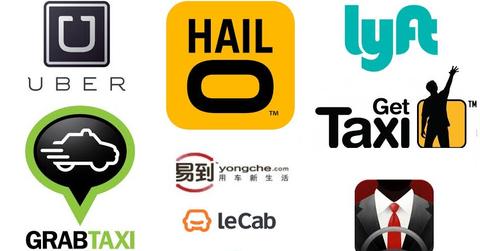Must-know: Assessing Uber’s current competitive landscape
Uber’s close competitors in the space include Lyft (60+ cities, U.S. only) and Hailo (10+ cities, international), though the two have slightly different business models.
June 20 2014, Published 3:09 p.m. ET

Uber’s competition
Uber’s close competitors in the space include Lyft (60+ cities, U.S. only) and Hailo (10+ cities, international), though the two have slightly different business models. Lyft pairs riders with drivers in the community through a mobile application. Hailo pairs riders with taxis through a mobile application. Uber riders can choose to ride in a regular car, ride in a black car, or get paired with a taxi. Though revenue figures aren’t public for these private companies, Uber appears to be the largest service, with the broadest geographic reach and deepest market penetration overall.
Other similar companies include the following (with main markets in parentheses).
- GrabTaxi (Southeast Asia)
- GetTaxi (Israel, Russia)
- leCab (France)
- Chauffeur-Prive (France)
- EasyTaxi (Brazil, Africa)
- Yongche (China)
Alternatives to services like Uber include public transportation (subway, buses), biking, car-sharing services such as Zipcar (ZIP), and private car ownership.
There are minimal to low switching costs between a service like Uber and Lyft, as well as between Uber and alternatives such as public transportation. Many users, as well as drivers, employ various services to get around or generate fares. Plus, the number of similar existing services, which have generally sprouted up within the past few years, shows the barriers to entering the market aren’t as prohibitive as, say, starting up a new fixed-capital and highly regulated business such as an airline, telecom company, or auto manufacturer. However, while starting a business similar to Uber might not be that expensive, gaining a significant customer base could be problematic if a company is already dominant. Market leaders in their geographic markets have a built-in advantage, given the network effects of this business. So, if Uber is already dominant in an area, more Uber customers results in more Uber drivers, which drives more Uber customers as the service becomes the most reliable.
Outlook
Though Uber in its current form operates as a service to connect passengers to drivers, the company could operate in the future as a logistics provider on the scale of FedEx (FDX) and United Parcel Service (UPS). Uber could also affect the operations of same-day delivery services provided by companies such as Amazon (AMZN) through Amazon Prime, or eBay (EBAY) through eBay Now. Plus, transportation could be completely changed with solutions that draw from Uber’s geographic reach and technology and the advent of driverless cars from a company such as Google (GOOG), which has funded part of Uber through its investment arm called Google Ventures. eBay, Google, FedEx, UPS, and Amazon are part of the S&P500 Index and corresponding ETF (SPY). We’ll discuss these themes later in this series.
